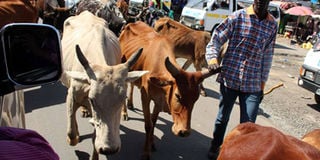Pastoralists turn to apps to find grazing fields

Cattle contend for space with vehicles and pedestrians in an urban centre. An new app called AfriScout was recently launched by Project Concern International to help pastoralists and herders access grazing points easily. FILE PHOTO | NMG
For as long as he has been a pastoralist, 47-year-old Isaac Ole Koyei has contended with the difficulties of finding pasture for his livestock, from his base in Ewaso Kedong, Kajiado County.
Ole Koyei’s herd which numbered about 630 cattle, sheep and goats, just a year ago, has since suffered an acute decline elicited by inadequate water and pasture, disease, and wild animal attacks.
Trekking to distant lands in search of pasture and water has been his way of life.
“It is hard to find pasture and water in this region where everyone is looking for a patch of grass for their large herds of livestock, yet the grazing fields are not getting any bigger.
“I have ventured as far as Naivasha and Njoro in Nakuru County in search of elusive grass to nourish my herd,” he says.
In Longido, Arusha, in northern Tanzania, Peter Kakenyi has been grappling with similar challenges.
“Pastoralism is our livelihood but we lose our animals to hunger, drought, wildlife, fatigue, disease and even attacks from our enemies.
“This poses a threat to our sustenance and survival,” he says from Monduli, nearly 120 kilometres away from his home, where he is currently grazing his animals.
Pastoralists relying on often unreliable traditional methods of finding pasture (such as scouting and word of mouth) and indigenous knowledge with all its limitations and disruptions from climate change and land use changes, lose up to a third of their herds every year.
In response to this challenge Project Concern International (PCI), an organisation whose mission is to empower people to enhance health, end hunger and overcome hardship, first created the Satellite Assisted Pastoral Resource Management (SAPARM) to provide pastoralists with community grazing maps overlaid with currently existing vegetation, using satellite imagery.
MAKE BETTER DECISIONS
The maps sought to provide information to enable pastoralists make better decisions on where and when to migrate their herds for grazing, in order to reduce potential livestock loss and mitigate the effects of climate change.
However, this proved unreliable since the maps lacked detail and were inaccessible to pastoralists on the move.
From the ashes of this failed project and in partnership with USAID, Google and iHub, PCI then launched AfriScout, a mobile phone application that displays current water points, pasture, vegetation, areas prone to diseases, areas where herders are likely to encounter wildlife or hostile conditions, and other circumstances that pastoralists need to know about before migrating.
These are displayed on localised grazing maps accessible through the application, enabling pastoralists to make more accurate and cost-effective migration decisions, improve pasture management and reduce the risk of loss.
“The maps are updated after every 10 days so herders are sure to get accurate information on availability of all the resources their livestock need at the click of a button,” says Brenda Wandera, PCI’s national programme manager and acting country representative.
Pastoralists post updates on places they encounter danger and adversity, livestock diseases and wildlife through their phones, thereby warning their fellow herders on apparent dangers.
Now up to seven million pastoralists in Kenya, no longer have to spend valuable time and money on a wild goose chase.
“I would spend more than Sh15,000 and a lot of time scouting for pasture, and was never guaranteed that I wouldn’t find that another herd had depleted the pasture I was eyeing by the time I got there,” Ole Koyei says.
According to PCI, pastoralists using AfriScout have registered a 48 per cent decline in their herds’ mortality, resulting in savings of over Sh506 million every year.
Ms Wandera adds that the app not only improved resilience and rangeland management, but also reduced the need for drought-related food aid for herders using it.



